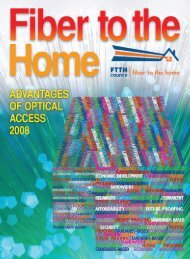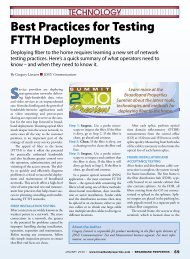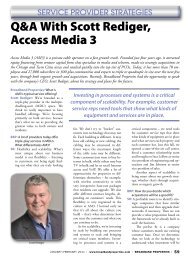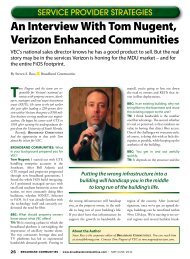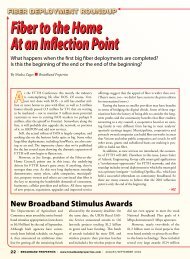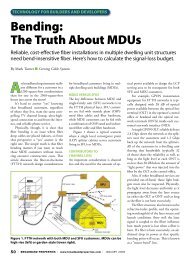bbpmag.com - Broadband Properties
bbpmag.com - Broadband Properties
bbpmag.com - Broadband Properties
You also want an ePaper? Increase the reach of your titles
YUMPU automatically turns print PDFs into web optimized ePapers that Google loves.
• In 3Q08, IP set-top boxes (STBs) account for 70 percent of<br />
the total IPTV and SDV equipment revenue.<br />
• IPTV middleware sales are up 21 percent in 3Q08, and<br />
video content protection software sales are up 14 percent.<br />
• In 3Q08, Motorola continued to lead the lucrative IP STB<br />
market, although Cisco increased its market share 6 points,<br />
putting it in a very close second place.<br />
• Harmonic maintains a strong lead in the worldwide IP<br />
video encoder market, leading all segments, including<br />
MPEG-2 and standard definition (SD) and high definition<br />
(HD) MPEG-4 encoders.<br />
• The <strong>com</strong>petitive operator Iliad Group of France leads in the<br />
number of IPTV subscribers, with 3 million in 3Q08.<br />
• North America is the leading region for total IPTV and<br />
Global <strong>Broadband</strong> Subscribers<br />
Reach 400 Million<br />
Global broadband subscribers have now reached the milestone<br />
of 400 million, according to a report prepared<br />
for the <strong>Broadband</strong> Forum by industry analysts Point<br />
Topic (www.point-topic.<strong>com</strong>). Since its inception, broadband<br />
has morphed from simple Internet access into triple play service<br />
delivery and has be<strong>com</strong>e an integral part of people’s lives, both<br />
at home and at work.<br />
In 1998 there were just 57,200 broadband subscribers globally.<br />
Only a year later, this number had increased nearly six<br />
times over, to 280,890 subscribers worldwide. DSL quickly became<br />
the most popular choice of delivery technology. The past<br />
10 years have seen a 600,000 percent increase in the number of<br />
subscribers – 300 percent in the last five years alone – to reach<br />
the 400 million mark.<br />
Independent <strong>com</strong>munications providers serving rural and<br />
high-cost areas have witnessed a dramatic rise in take rates<br />
for their broadband offerings, despite increasing <strong>com</strong>petition,<br />
according to survey results from the National Tele<strong>com</strong>munications<br />
Cooperative Association (NTCA).<br />
All of the respondents to NTCA’s annual <strong>Broadband</strong>/Internet<br />
Availability Survey offer broadband to some part of their<br />
customer base, <strong>com</strong>pared to just 58 percent of respondents in<br />
the 2000 survey. Nearly all (93 percent) of respondents indicated<br />
they face <strong>com</strong>petition in the provision of advanced services<br />
from a diverse group including ISPs, WISPs, cable <strong>com</strong>panies,<br />
electric utilities and local ISPs.<br />
Ninety-nine percent of respondents indicated they use DSL to<br />
provide Internet access, though fiber deployment is seeing some<br />
gains, with 44 percent employing fiber to the home (FTTH) or<br />
SDV revenue due to the fierce rivalry between telcos and cable<br />
operators, but Europe is running a close second. BBP<br />
Over the same period, access technology evolved to include<br />
fiber, which began in 2002 with 18,000 subscribers. Fiber networks<br />
now deliver broadband services to over 45 million people<br />
across the globe.<br />
Oliver Johnson, senior analyst with Point Topic, explains,<br />
“When Point Topic started researching broadband in 1998 it<br />
was still mostly in the technical trial stage. Getting to 400 million<br />
subscribers in the 10 years since then has been one of the<br />
fastest rollouts of a major new technology the world has ever<br />
seen. Now we’re in the early days of a new era, which is going<br />
to be much more about quality than quantity. The emphasis is<br />
now going to shift to providing high-bandwidth, high-quality<br />
broadband that can deliver multiple, steady, pin-sharp images<br />
for applications.” BBP<br />
Independent Telcos Make <strong>Broadband</strong><br />
Available in Rural America<br />
fiber to the curb, up from 32 percent the previous year.<br />
Seventy-one percent of respondents with a fiber deployment<br />
strategy plan to offer fiber to the node to more than threequarters<br />
of their customers by the end of 2009, with 74 percent<br />
planning to offer FTTH to 25 percent of their customers over<br />
that same time frame. The majority of respondents (86 percent)<br />
identified the costs of fiber deployment as the most serious challenge<br />
to their efforts.<br />
An increasing number of providers are offering a video play,<br />
with 68 percent of respondents indicating a current video offering,<br />
up from 63 percent in 2007. This year’s survey also saw a<br />
slight decrease in voice over Internet protocol (VoIP) offerings,<br />
down one percent from 2007, though nearly half the respondents<br />
(44 percent) said they do have plans to offer VoIP in the<br />
foreseeable future. BBP<br />
14 | BROADBAND PROPERTIES | www.broadbandproperties.<strong>com</strong> | January/February 2009



